Resident Crews of the Mir
![]()
Mir: Expedition 19 |
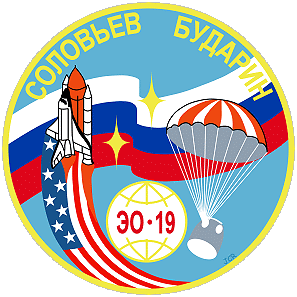 |
 |
|
alternative crew photo |
|
alternative crew photo |
![]()
Crew, launch- and landing data
| No. | Nation | Surname | Given names | Position | Spacecraft (launch) |
Launch date |
Launch time |
Spacecraft (landing) |
Landing date |
Landing time |
Mission duration |
Orbits |
| 1 | Soloviyov | Anatoli Yakovlevich | Commander | STS-71 | 27.06.1995 | 19:32:18.988 UTC | Soyuz TM-21 | 11.09.1995 | 06:52:40 UTC | 75d 11h 20m 21s | 1194 | |
| 2 | Budarin | Nikolai Mikhailovich | Flight Engineer | STS-71 | 27.06.1995 | 19:32:18.988 UTC | Soyuz TM-21 | 11.09.1995 | 06:52:40 UTC | 75d 11h 20m 21s | 1194 |
Backup Crew
| No. | Nation | Surname | Given names | Position |
| 1 | Onufriyenko | Yuri Ivanovich | Commander | |
| 2 | Usachyov | Yuri Vladimirovich | Flight Engineer |
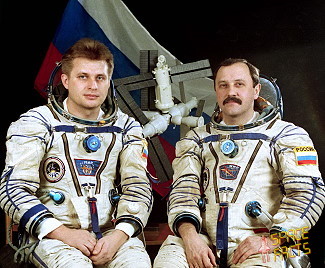 |
Expedition Report
|
Launch from Cape Canaveral (KSC). The primary objectives of this flight were to rendezvous and perform the first docking between the Space Shuttle and the Russian space station Mir on June 29, 1995. In the first U.S.-Soviet docking in twenty years, Atlantis delivered a relief crew of two cosmonauts Anatoli Soloviyov and Nikolai Budarin to Mir. Other prime objectives were on-orbit joint United States of America-Russian life sciences investigations aboard SPACELAB/Mir, logistical resupply of the Mir and returning of US astronaut Norman Thagard. STS-71 marked a number of historic firsts in human spaceflight history: the 100th U.S. human space launch conducted from the Cape; first U.S. Space Shuttle-Russian space station docking and joint on-orbit operations; largest spacecraft ever in orbit; and the first on-orbit changeout of a Shuttle crew. STS-71's rendezvous and docking with the Russian space station Mir actually began with the precisely timed launch of Atlantis on a course for the station. Over the next two days, periodic small engine firings gradually brought Atlantis to a point eight nautical miles behind Mir. At that time, on the third day of the flight, a Terminal Phase Initiation (TI) burn was fired, and the final phase of the rendezvous began. Atlantis closed the final eight nautical miles to Mir during the next 90-minute orbit. As Atlantis moved in, the Shuttle's rendezvous radar system began tracking Mir and provided range and closing rate information to the Shuttle crew. As Atlantis neared Mir, the Trajectory Control Sensor, a laser ranging device mounted in the payload bay, supplemented the Shuttle's onboard navigation information by supplying additional data on the range and closing rate. Docking occurred at 13:00 UTC, June 29, 1995, using R-Bar or Earth radius vector approach, with Atlantis closing in on Mir from directly below. R-bar approach allows natural forces to brake the orbiter's approach more than would occur along standard approach directly in front of the space station; also, an R-bar approach minimizes the number of orbiter jet firings needed for approach. The manual phase of the docking began with Atlantis about a half-mile (800 m) below Mir, with Robert Gibson at the controls on aft flight deck. Stationkeeping was performed when the orbiter was about 75 meters (246 ft) from Mir, pending approval from Russian and U.S. flight directors to proceed. Robert Gibson then maneuvered the orbiter to a point about 10 meters (33 ft) from Mir before beginning the final approach to station. Closing rate was close to the targeted 0.1 foot per second (30 mm/s), being approximately 0.107 foot per second (33 mm/s) at contact. Interface contact was nearly flawless: less than 25 millimeters (0.98 in) lateral misalignment and an angular misalignment of less than 0.5 degrees per axis. Docking occurred about 216 nautical miles (400 kilometers (250 mi)) above Lake Baikal region of the Russian Federation. Docking began when the orbiter was maneuvered to bring the interfaces of the active docking mechanism in contact with Mir's passive mechanism. At this point, the maximum allowable axial rate of approach of the two vehicles was 0.2 foot per second (6 centimeters per second). Minor misalignments of the two mechanisms of up to eight inches and five degrees were corrected as the orbiter interface was displaced and rotated so the capture ring could latch onto the opposing androgynous interface ring. This rotation was produced by the relative velocity of the two vehicles. Soft latching occurred when the capture ring alignment was complete and the interfaces were aligned. Each of the petals on Atlantis' APAS was equipped with two capture latches. The capture latch assemblies, which operated independently, grapple body mounts on the Mir APAS. Five seconds after capture, dampers designed to reduce relative vehicle motion were activated for 30 seconds. Before the dampers were activated, a load-limiting clutch prevents either vehicle from being overloaded. The dampers were deactivated to allow the dampers to align the vehicles. After the relative motion of the two vehicles had subsided, the retraction phase of the docking process then began. During this phase, the latched capture ring and passive vehicle were pulled into the orbiter mechanism. The five engaged fixators made the capture ring rigid and prevent relative vehicle misalignments from accumulating during retraction. Structural latching occurred at the completion of the capture ring retraction process. Twelve active structural latches located at the structural interface are grouped into two separate activated gangs of six latches each. A passive, immobile hook is located next to each active latch. The Mir mechanism also had these latches and hooks. In the process of structurally latching the orbiter and Mir, latch actuator motors deployed the orbiter's active latches, which hooked onto Mir's passive hooks. The actuator drives the first hook directly, and a cable transmitted power to the remaining five slave hooks. The hooks were driven beyond the point where the hook was overcenter. The overcenter hooks carried the sealing load, rather than the cables. Mir's active latches could also be used to hook onto the orbiter's passive hooks as a backup procedure. The entire docking process was completed in less than one hour. The final portion of the process, after capture, took approximately 15 minutes. Atlantis and Mir were linked by an orbiter docking system (ODS). The $95.2-million orbiter docking system consisted of an external airlock, a supporting truss structure, a docking base, avionics required to operate the system, and a 632-pound (286.7 kg) Russian-built docking mechanism, called the androgynous peripheral assembly system (APAS), which was mounted on top of the airlock and docking base. Atlantis received extensive wiring changes to accommodate the new system, which measured nearly 15 feet (4.57 meters) wide, 6-½ feet (1.98 meter) long, and 13-½ feet (4.11 meters) high and weighed more than 3,500 pounds (1,587 kg). It was installed near the forward end of the orbiter's payload bay and was connected by short tunnels to the existing airlock inside the orbiter's pressurized crew cabin and the pressurized Spacelab module, which was aft of the airlock in the payload bay. The ODS worked flawlessly during the docking sequence. The APAS was a hybrid version of the docking system the Russians used in 1975 for the Apollo-Soyuz Test Project. It differed from its predecessor in several key respects. First, it was much more compact, with an overall external diameter of 60 inches (152 centimeters) compared to 80 inches (203 centimeters) on ASTP, although the inner egress tunnel diameter remained approximately the same. Second, the APAS docking mechanism had 12 structural latches, compared to eight on the ASTP. Third, the APAS guide ring and its extend/retract mechanism were packaged inside the egress tunnel rather than being outside of the mechanism as they were on ASTP. Finally, the three guide petals on the APAS pointed inboard rather than outboard. Both Atlantis and Mir were equipped with an APAS, which consisted of a three-petal androgynous capture ring mounted on six interconnected ball screw shock absorbers, which operated like a sophisticated car suspension system. The absorbers arrested the relative motion of the two vehicles and prevented them from colliding. When linked, Atlantis and Mir formed the largest spacecraft ever in orbit, with a total mass of about 225 metric tons (almost one-half million pounds), orbiting some 218 nautical miles (404 kilometers (251 mi)) above the Earth. After hatches on each side opened, STS-71 crew passed into Mir for a welcoming ceremony. With the Russian and U.S. flags as a backdrop, the STS-71 and Mir crews exchanged gifts on flight day four in the Shuttle's Spacelab module. Gifts included a halved pewter medallion bearing a relief image of a docked Shuttle and Mir space station; the two halves were joined during the ceremony. A 1/200th-scale model of the Shuttle and the Mir also was joined. These gifts were presented to the U.S. and Russian Heads of State and the leaders of the two space agencies after the mission. For five days, about 100 hours in total, joint U.S.-Russian operations were conducted, including biomedical investigations, and transfer of equipment to and from Mir. Fifteen separate biomedical and scientific investigations were conducted, using the Spacelab module installed in the aft portion of Atlantis's payload bay, and covering seven different disciplines: cardiovascular and pulmonary functions; human metabolism; neuroscience; hygiene, sanitation and radiation; behavioral performance and biology; fundamental biology; and microgravity research. The Mir-18 crew served as test subjects for investigations. Three Mir-18 crew members also carried out an intensive program of exercise and other measures to prepare for re-entry into gravity environment after more than three months in space. Numerous medical samples as well as disks and cassettes were transferred to Atlantis from Mir, including more than 100 urine and saliva samples, about 30 blood samples, 20 surface samples, 12 air samples, several water samples and numerous breath samples taken from Mir-18 crew members. Also moved was a broken Salyut 5 computer. Transferred to Mir were more than 450 kilograms (990 lb) of water generated by the orbiter for waste system flushing and electrolysis; specially designed spacewalking tools for use by the Mir-19 crew during a spacewalk to repair a jammed solar array on the Spektr module; and transfer of oxygen and nitrogen from Shuttle's environmental control system to raise air pressure on the station, to improve Mir's consumables margin. Joint scientific investigations by the two premier spacefaring nations continued with the flight of STS-71, the Spacelab-Mir mission, providing more knowledge about the human body and the microgravity environment. Research in seven different medical and scientific disciplines begun during Mir-18 was concluded on STS-71. Of the 28 experiments being conducted as part of the joint United States-Russian cooperative effort, 15 was performed as part of the STS-71 mission. The metabolic research on STS-71 included studies of the cardiovascular and pulmonary systems; neurosensory research; hygiene, sanitation, and radiation research; behavior and performance research; fundamental biology research; and microgravity research. Deconditioning of the cardiovascular and pulmonary system, with the occurrence of orthostatic intolerance (or lightheadedness upon standing) observed in returning crew members of long duration spaceflight is of primary interest to researchers. Researchers measured changes in blood volume during flight and the pooling of blood in the legs and abdomen upon reentry. Investigations in neurosensory research begun during Mir-18 focused on the mixed messages the body receives when the brain integrates nerve impulses from the eyes, inner ear, muscles and joints. The brain can no longer rely on gravity as a constant in determining body position and orientation. Two of these studies seek to enhance our understanding of how humans adapt to spaceflight and readapt to Earth's environment. Two investigations in hygiene, sanitation, and radiation research looked at the radiation environment experienced during an extended stay in space, and two others looked at the presence of microbes or trace chemicals found in the air and water consumed by the astronauts. Data from tests to study the long-term effects of microgravity on muscle coordination and mental acuity, collected during more than three months on Mir-18, were returned to Earth aboard Atlantis. A Russian spacecraft control simulator used before, during and after flight, allowed researchers to measure crew member's functional state and manual control performance. STS-71 studied how weightlessness affects embryo development by returning to Earth a set of pre-fertilized quail eggs incubated on board Mir. The incubation process was stopped at various stages of development, and the embryos placed in a fixative solution for later analysis. Improved sensors were carried to orbit by Atlantis to be added to the Mir station greenhouse by the Mir-19 crew. The updated greenhouse then was ready for plant experiments on future NASA-Mir missions. STS-71 carried several hundred protein samples, frozen in a thermos-bottle-like vacuum jacket or dewar, to the Mir space station. After they thaw, the proteins crystallized until the dewar is retrieved by the STS-74 crew in November 1995. The months-long growing time aboard Mir should produce large protein crystals of sufficient size and quality to compare with corresponding crystals grown in Earth-based laboratories. The Mir experiment was used to evaluate the effectiveness of flash-frozen bath and liquid-liquid diffusion techniques for growing protein and virus crystals on long-duration space missions. Experience gained will help shape PCG investigations to be conducted aboard the International Space Station. The Mir resident crew was exchanged. Anatoli Soloviyov and Nikolai Budarin became the 19th resident crew. The former 18th resident crew (Vladimir Dezhurov, Gennadi Strekalov, Norman Thagard) returned to Earth with STS-71. After over 100 hours of docked operations, the hatches were closed on both Atlantis and the Mir, and the vestibule in the Shuttle's docking system was depressurized. The initial separation was performed by springs that slightly pushed the Shuttle and the Mir away from each other on a command sent to the docking mechanism from an aft flight deck control panel in Atlantis. Both the Mir and Atlantis were in a mode called "free drift" during the undocking, a mode that has the steering jets of each spacecraft shut off to avoid any inadvertent firings. STS-71 left Mir on July 04, 1995. The separation of STS-71 was observed from the also separated Soyuz spacecraft. The first EVA was performed by Anatoli Soloviyov and Nikolai Budarin on July 14, 1995 (5h 34m). The cosmonauts repaired the solar array and they inspected the exterior of the space station. They discovered no pollution or damages on the outside of the docking mechanism of the -Z axis. They deployed the jammed solar array on Spektr with the exception of 1 section. The solar array has now been included in the power supply system of the complex. They also worked at a solar array of Kvant2 and an antenna. Module Kristall was moved from the forward port (-X axis) to the side port (-Z axis) on July 17, 1995 between 02:30 and 04:00 UTC. The redocking took place by the use of the 'lyappa'. a manipulator arm. So Kristall was now in the right position to receive the Atlantis (STS-74) and the new docking module in October 1995. On July 17, 1995 Anatoli Soloviyov reported that the airseal of the system after the redocking was normal. Anatoli Soloviyov and Nikolai Budarin went out of Mir to conduct the second spacewalk on July 19, 1995 (3h 08m). The cosmonauts did not accomplish their tasks and the EVA was shorter than planned. The thermoregulation in the spacesuit of Anatoli Soloviyov was not working normally. He got orders to remain in the hatch of the airlock and observe the activities of his crew mate. Nikolai Budarin did some preparations for the installation of the Belgian MirAS experiment and brought back some materials from Mir's outer surface. The third and final EVA occurred on July 21, 1995 (5h 50m). The main task of the crew consisted of the installation of the Belgian Spectrometer, MirAS, on the outer surface of the Spektr module. The EVA was a success. During the EVA the geostationary satellite Altair (west) has not been used during all possible windows and if so only for voice communications. The recorded images have been transmitted to Earth after the EVA. The freighter Progress M-28 blasted off from Baikonur on July 20, 1995 at 03:04:40 UTC for a 2-days flight to the Mir space station. The vessel docked with Mir's front port on July 22, 1995 at 04:39:37 UTC, undocked on September 04, 1995 at 05:09:53 UTC and was destroyed in reentry on September 04, 1995 at 08:58:55 UTC. Soyuz TM-22 with the Mir-20 crew was launched from Baikonur on September 03, 1995 at 09:00 UTC. Soyuz TM-22 carried the relief crew to the Mir station together with the ESA astronaut, the German, Thomas Reiter. The Russian crew consisted of the Mir Commander Yuri Gidzenko, who made his first spaceflight, and Flight Engineer Sergei Avdeyev, who already made one spaceflight. Soyuz TM-22 docked with Mir's front (-X) port at 10:29:54 UTC on September 05, 1995 and the hatch was opened at 11:01:23 UTC. The Soyuz spacecraft is composed of three elements attached end-to-end - the Orbital Module, the Descent Module and the Instrumentation/Propulsion Module. The crew occupied the central element, the Descent Module. The other two modules are jettisoned prior to re-entry. They burn up in the atmosphere, so only the Descent Module returned to Earth. Having shed two-thirds of its mass, the Soyuz reached Entry Interface - a point 400,000 feet (121.9 kilometers) above the Earth, where friction due to the thickening atmosphere began to heat its outer surfaces. With only 23 minutes left before it lands on the grassy plains of central Asia, attention in the module turned to slowing its rate of descent. Eight minutes later, the spacecraft was streaking through the sky at a rate of 755 feet (230 meters) per second. Before it touched down, its speed slowed to only 5 feet (1.5 meter) per second, and it lands at an even lower speed than that. Several onboard features ensure that the vehicle and crew land safely and in relative comfort. Four parachutes, deployed 15 minutes before landing, dramatically slowed the vehicle's rate of descent. Two pilot parachutes were the first to be released, and a drogue chute attached to the second one followed immediately after. The drogue, measuring 24 square meters (258 square feet) in area, slowed the rate of descent from 755 feet (230 meters) per second to 262 feet (80 meters) per second. The main parachute was the last to emerge. It is the largest chute, with a surface area of 10,764 square feet (1,000 square meters). Its harnesses shifted the vehicle's attitude to a 30-degree angle relative to the ground, dissipating heat, and then shifted it again to a straight vertical descent prior to landing. The main chute slowed the Soyuz to a descent rate of only 24 feet (7.3 meters) per second, which is still too fast for a comfortable landing. One second before touchdown, two sets of three small engines on the bottom of the vehicle fired, slowing the vehicle to soften the landing. Soyuz TM-21 landed on September 11, 1995 at 06:52 UTC with the crew of Nikolai Budarin and Anatoli Soloviyov aboard. |
EVA data
| Name | Start | End | Duration | Mission | Airlock | Suit | |
| EVA | Budarin, Nikolai | 14.07.1995, 03:56 UTC | 14.07.1995, 09:30 UTC | 5h 34m | Mir-19 | Mir - Kvant2 | Orlan-DMA No. 18 |
| EVA | Soloviyov, Anatoli | 14.07.1995, 03:56 UTC | 14.07.1995, 09:30 UTC | 5h 34m | Mir-19 | Mir - Kvant2 | Orlan-DMA No. 27 |
| EVA | Budarin, Nikolai | 19.07.1995, 00:39 UTC | 19.07.1995, 03:47 UTC | 3h 08m | Mir-19 | Mir - Kvant2 | Orlan-DMA No. 18 |
| EVA | Soloviyov, Anatoli | 19.07.1995, 00:39 UTC | 19.07.1995, 03:47 UTC | 3h 08m | Mir-19 | Mir - Kvant2 | Orlan-DMA No. 27 |
| EVA | Budarin, Nikolai | 21.07.1995, 00:28 UTC | 21.07.1995, 06:18 UTC | 5h 50m | Mir-19 | Mir - Kvant2 | Orlan-DMA No. 18 |
| EVA | Soloviyov, Anatoli | 21.07.1995, 00:28 UTC | 21.07.1995, 06:18 UTC | 5h 50m | Mir-19 | Mir - Kvant2 | Orlan-DMA No. 27 |
Relocations of Manned Spacecrafts
| Spacecraft | from | Undocking | Time UTC | to | Redocking | Time UTC |
| Soyuz TM-21 | Mir - Kvant | 04.07.1995 | 10:55:01 | Mir - Kvant | 04.07.1995 | 11:38:12 |
Photos / Graphics
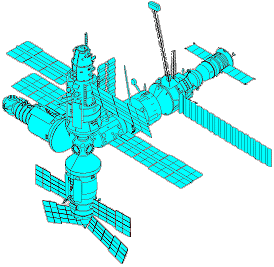 |
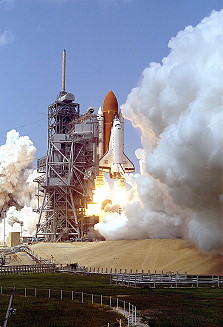 |
 |
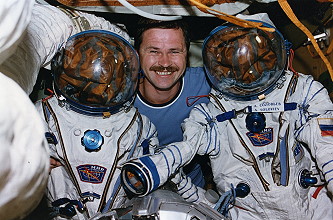 |
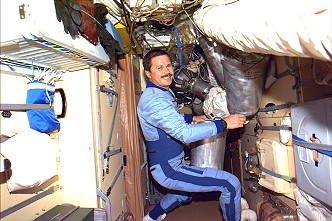 |
| © |  |
Last update on May 22, 2021.  |
 |